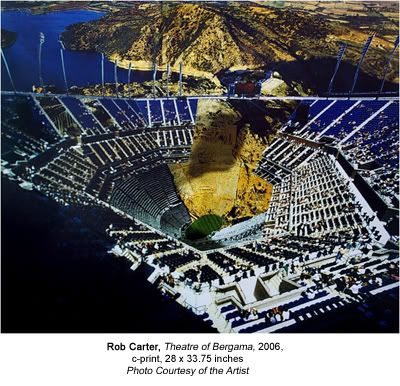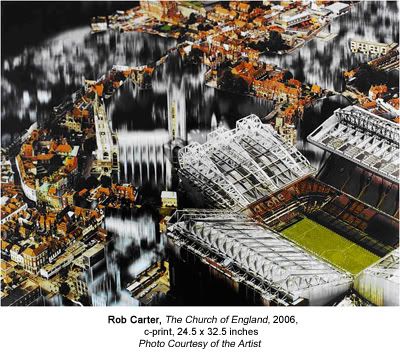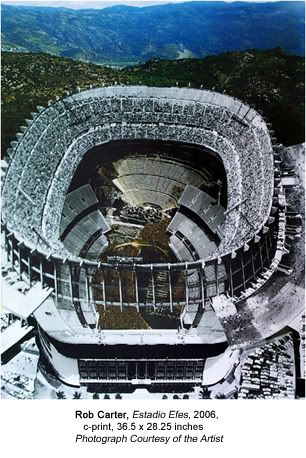
My videos and photographs examine paper as both a physical object and a malleable document of time. The imagery often relies on theatrical manipulation or illusion, but uses these mechanisms in order to inform or expand the meaning or reading of the imagery, rather than to fool the viewer’s sense of what is real. My recent work employs video animation and photographic ‘re-constructions’ that use the theatricality of architecture and landscape as a platform to spotlight the iconic and political structures of sports stadia. – Rob Carter
While there are often strong connections drawn between those who work with collaged or digitally manipulated photographs to the Surrealist movement, the video and photographs of Rob Carter tend to avoid at least some of these references. Yes, he transplants sports stadiums to unlikely landscapes which is undoubtedly evocative of the early 20th century practice, but Carter is less concerned about creating dreamlike imagery typically associated with Surrealism -the biomorphic, the fecal, the natal and other absurdities, than he is drawing attention to the evolving socio and political of stadiums. Like many contemporary artists, the philosophy that differentiates Carter’s work from this movement is one that subscribes to the belief that man’s most able self is his conscious self-his intending self*
Interestingly, Surrealism and many artists and movements that followed in a similar vein of working, were often very politically minded. While it’s possible that collage is simply a popular art practice, it’s hard not to notice that the medium is particularly common among artists who employ social art tactics. Max Ernst, Paul-Émile Borduas and Les automatistes, and Martha Rosler to name just a few, frequently used collage as a method of communicating a particular agenda.
Now, it is probably a mistake to attach the large political ambitions of these artists to the Carter’s photographs of collaged material — just because they have a social message, it does not mean that they are created with the intent to mobilize the masses. However, I do think that this tradition is one that helps contextualize the work that he is making. Carter is continuing in a tradition established by some of the most innovative artists of the twentieth century creating virtuoso photographs that critique sports culture, urban planning and development, and even larger political and social structures.
Take for example, Carter’s recent photograph, The Church of England. In this piece, the black and white documentation of the city appears to be in the process of being forcefully removed. The church, which once dominated the landscape, is either warped in form or nearly absent, and in its place Carter lays in a large sports stadium hybrid. But the new architecture suggests that the building houses an empty belief. Marked over chairs meant to seat thousands someone has written the word alone, and while it is unclear if this is the hand of the artist or merely part of the documentation, in either case the result is the same. The text and imagery is a poignant reminder of the impermanence to the things we attach the greatest value to.
Artist Paul Pfieffer, who incidentally is also a Hunter College graduate, explored similar themes in video works such as John 3:16, and Fragment of a Crucifixion (After Francis Bacon), though these videos also critiqued of racial politics, spectacle and media culture. In contrast, Carter’s photographs and videos are much more about the changing landscape of Western countries, most specifically Europe. Estadio Efes, and Elgar Sings the Blues reinforces this idea as these giant stadiums are rebuilt in remote landscapes that equal their grandeur.
Strangely, these buildings do not appear to be grossly out of place, nor is there any concern about how or if they will be used. While one could easily make the argument that by overlaying stadiums in locations where they could not be used, the artist is questioning their value, I think that reading is more simplistic than the work deserves. This is an element to the videos and photographs no doubt, but it also pays homage to the school of thought that God lies within landscape, and that architecture and sport is one of many ways in which we try to either rival or create our own Gods. However, unlike the rules of the game, there are no steadfast winners and losers, beginnings and endings. We do not create Gods of permanence; we indefinitely remake the face of God.
*Ben Shahn, The Shape of Content, pages 42-43, (from The Charles Eliot Norton Lectures, 1956-1957)




Comments on this entry are closed.